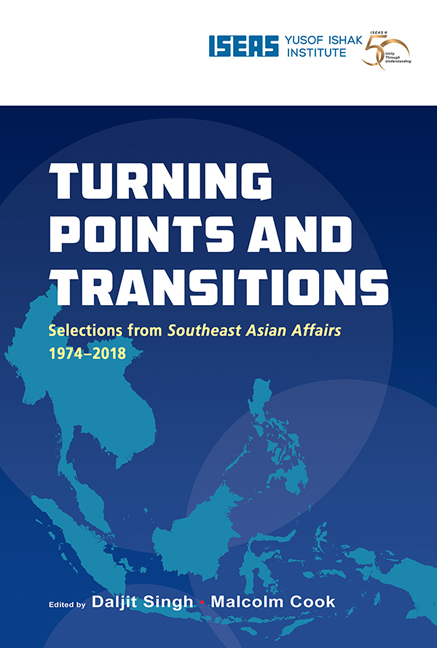Book contents
- Frontmatter
- Contents
- Message from the Director
- Foreword
- Foreword
- Introduction
- THE REGION
- BRUNEI
- CAMBODIA
- Cambodia and Regional Diplomacy (1982)
- Kampuchea 1979–81: National Rehabilitation in the Eye of an International Storm (1982)
- Cambodia 1991: Lasting Peace or Decent Interval? (1992)
- Hun Sen's Pre-emptive Coup: Causes and Consequences (1998)
- Cambodia in 2017: Plus ça change… (2018)
- INDONESIA
- LAOS
- MALAYSIA
- MYANMAR
- THE PHILIPPINES
- SINGAPORE
- THAILAND
- VIETNAM
Cambodia 1991: Lasting Peace or Decent Interval? (1992)
from CAMBODIA
Published online by Cambridge University Press: 29 May 2019
- Frontmatter
- Contents
- Message from the Director
- Foreword
- Foreword
- Introduction
- THE REGION
- BRUNEI
- CAMBODIA
- Cambodia and Regional Diplomacy (1982)
- Kampuchea 1979–81: National Rehabilitation in the Eye of an International Storm (1982)
- Cambodia 1991: Lasting Peace or Decent Interval? (1992)
- Hun Sen's Pre-emptive Coup: Causes and Consequences (1998)
- Cambodia in 2017: Plus ça change… (2018)
- INDONESIA
- LAOS
- MALAYSIA
- MYANMAR
- THE PHILIPPINES
- SINGAPORE
- THAILAND
- VIETNAM
Summary
On 23 October 1991 Cambodia took a tentative step towards lasting peace when the four Khmer factions and 19 countries signed a UN-brokered peace accord in Paris which ended the 13-year-old war in Cambodia. It is at best a fragile peace as indicated by the series of violent events — the mob attack on Khmer Rouge leaders and demonstrations against corruption — that took place in Phnom Penh after the signing of the peace accord.
To understand how “peace” finally returned to Cambodia, it is necessary to examine the events that led to the first “breakthrough” in June which in turn led to the signing of the peace accord on 23 October. Before doing that, it may be useful to understand what the peace accord actually entails.
The UN Peace Accord: Main Features
Under the accord, the United Nations Transitional Authority in Cambodia (UNTAC) will, on the advice of the 12-member Supreme National Council (SNC) headed by Prince Norodom Sihanouk, run the country until UN-supervised free elections are held, probably in April 1993. The day-to-day administration will continue to be in the hands of the State of Cambodia (SOC), the regime installed by Vietnamese forces in January 1979, while UNTAC will oversee the running of five key ministries — defence, finance, foreign affairs, interior and information.
During this period, a 10,000-member UN peace-keeping force will be deployed inside Cambodia to enforce the ceasefire — in place since 1 May 1991 — and to demobilize the four Khmer factions. Under a compromise agreement, 70 per cent of each of the four rival armies will be demobilized by UNTAC — which is expected in Cambodia in April or May 1992 — with the remaining 30 per cent to be held in UNTAC-controlled cantonments until just before the elections when they are expected to be totally demobilized or absorbed into a new Cambodian national army under the new government.
About four million out of the 8.5 million Cambodians are eligible to vote, and they will choose a 120-member national assembly, based on the electoral system of proportional representation. Political parties with a minimum of 5,000 members will be eligible to contest the elections. The presidential election is expected to be held immediately after the elections for the national assembly.
- Type
- Chapter
- Information
- Turning Points and TransitionsSelections from Southeast Asian Affairs 1974-2018, pp. 227 - 243Publisher: ISEAS–Yusof Ishak InstitutePrint publication year: 2018



